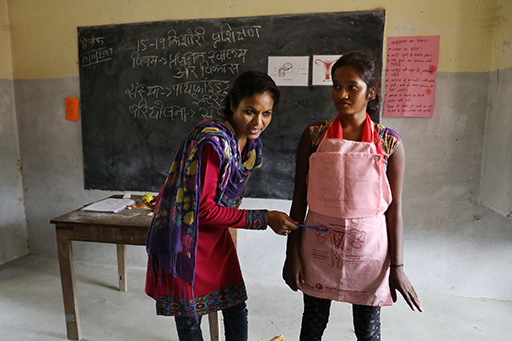Use 'Print preview' to check the number of pages and printer settings.
Print functionality varies between browsers.
Printable page generated Thursday, 20 November 2025, 4:46 PM
Learning Session 4: Pleasure anatomy
Introduction
This session aims to help you to ensure that sexual pleasure is included in sessions which focus on the body and anatomy.
Sexuality education has often focused on bodies and anatomy. While this is obviously a very important element, it’s also now agreed that a more modern and positive approach to teaching about sexuality includes a wider understanding of sexuality and wellbeing – and sexual pleasure in particular. If we only teach about bodies in relation to reproduction, we exclude young people who want sex but not children, and people who cannot have children but still want to have sex.
When teaching about pleasure and the body it’s a good idea to start gently, by talking about sensitive parts of the body before focusing specifically on the sexual organs, arousal and orgasm. This is also the structure that this learning session follows. The last section of this learning session talks about the importance of recognising that ‘good feelings’ in your mind and emotions carry through to your body for a complete and satisfying sexual experience.
Like all the learning sessions in Part Two, this learning session aims to offer you lots of ideas for activities to use within your existing CSE sessions. It contains a mixture of activities for you to do yourself to prepare for teaching, and activities to use within a CSE session. By the end of Session 4 you should:
- Have some new ideas about how to include pleasure within CSE sessions you are leading which focus on the body and anatomy
- Feel more confident about including pleasure within the learning sessions that you are teaching.
4.1 Sensitive parts of the body
Our first activity starts gently by exploring the sensitive parts of the body. It aims to help young people to understand that sexual pleasure comes from more than just the genitals.
Activity 4.1: Body parts
Draw two gender-neutral bodies on a whiteboard, chalkboard or sheet of paper, one from the front, one from the side, like this:
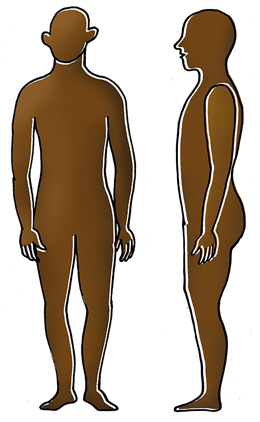
Now ask the group ‘What parts of the body are involved in sex, desire and pleasure? If no one mentions the brain (where much sexual response actually starts), you can add it and ask what they think you mean.
Make sure that all the areas with lines shown in the pictures below are mentioned. If not, you can point to an area and ask ‘what about this part?’ You can explain that different parts of the body are more or less sensitive or pleasurable for different people.
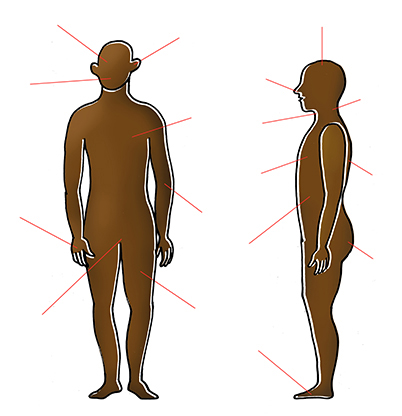
The next two sections focus on the sexual organs but the points made by this activity are really important as well: that many parts of the body can be sexually sensitive; that different people find different parts of the body sexual; and that the brain and emotions play a vital role in sexual arousal.
4.2 Different words for different contexts
The next two activities are for you to do on your own, to help you prepare to lead sessions on pleasure and anatomy. It will help you to reflect on which words for sexual organs you feel more and less comfortable using, and aims to make it easier for you to use appropriate terminology within your CSE sessions.
Activity 4.2: Which words do you use?
Look at the words you have written in the box above and ask yourself these questions:
- Which words have positive or negative associations for you?
- Can you see any differences between the genders, for example, do you know as many different words for the vagina as for the penis?
- Are there any words that could be seen as offensive – why? Could you use the same words but with new associations? If so, what would these be?
- What words do you feel comfortable using in the following settings?
- a.when talking to your friends?
- b.when talking to different family members?
- c.when talking to a young child?
- d.when talking to a doctor?
- e.when talking to a sexual partner?
- f.in your CSE class?
Discussion
Here are the words that one member of the writing team, working in English, thought of. They are just their personal responses, your answers will probably be different – there are no right or wrong answers in this exercise.
Penis, vagina, vulva, clitoris, testicles, dick, cock, balls, fanny, crown jewels, trouser snake, willy
And here are the answers they gave to the questions:
- Positive associations: cock, clitoris. Negative associations: fanny, dick, trouser snake, crown jewels
- I know many more words for the male sexual organs than female
- Some people think cock is offensive and it is sometimes used as an insult but I like it as a word so I’ve given it new positive associations.
-
- a.To my friends I’m not sure! Possibly the ‘correct’ ones like penis, vagina, vulva, etc. Or, if it was a good friend I might say cock.
- b.For different family members definitely the ‘correct’ ones!
- c.To a young child definitely willy and probably vulva
- d.To my doctor, obviously the more medical ones
- e.To my sexual partner the ones we both like
- f.In a CSE class I’d include the ‘correct’ ones, but I might also say willy and balls to use more everyday language. I might say fanny as well, even though I don’t like it much, but it could be useful as a less offensive slang term.
We often think of terms for the sexual organs as either ‘correct’ or ‘rude’ but it’s more helpful to think of all the different terms as a resource – a bit like a toolbox where you choose which tool is best for a particular communication.
In a CSE session, it’s important that you are direct and specific and use language which is familiar to young people as well as more scientific terms. The young people in your sessions may use different terms than those you are used to, and they need to be able to express themselves comfortably in the classroom setting, without worrying about being offensive to you or to each other.
Remember that not everyone will have the same sensibilities when it comes to language, and talking about sexual matters requires sensitivity to the feelings of others. So any terms you feel may be questionable should be discussed in an open and honest way.
Rather than telling young people a term is ‘wrong’, open it up in class for discussion. You might all learn something!
The next activity is very quick, but is worth spending a few minutes on, to help you get more comfortable with talking about the genitals. This is an activity for you to do before your CSE sessions.
Activity 4.3: Saying the words
Say all the words in your toolbox out loud. Were any words difficult to say out loud? Maybe you whispered some, and that’s okay. We all have different associations and emotions relating to words about sexuality. If any words were difficult, say them out loud several times, maybe in front of a mirror.
As a last step, you can practise saying them in front of a friend. Remember: it’s okay to feel embarrassed, blush or giggle, but practising like this beforehand will make it less likely that you feel embarrassed during a CSE session.
4.3 The sexual organs
The next activity is a resource for teaching about the sexual organs in a CSE session.
Activity 4.4: Naming the sexual organs
Draw a vulva and a penis, labelling the parts in the language in which you are teaching. You can find sample images to print out in the image bank, including versions with English labels and no labels so that you can add them.
Point to the different parts and ask if they know what each is. Then explain briefly. It is useful to point out that the female and male sexual organs are very similar and basically made up of the same parts.
The skin that in one foetus becomes the outer lips of the vulva becomes a scrotum in another foetus. The same root forms ovaries or testicles, and both the clitoris and the penis have a head and a hood (if not circumcised). There is more information about the clitoris in Activity 4.6.
You might notice that the diagrams in the image bank use the term ‘vaginal corona’ instead of hymen. You can use whichever term you think is most suitable to your group and your context. The term ‘vaginal corona’ was invented by the Swedish Association for Sexuality Education (RFSU) in 2009 to try to dispel myths about hymens by using a new word.
You can also do an exercise similar to the one in Activity 4.3 in your CSE groups, to help young people think about the different words they know for the sexual organs and which types of words might be appropriate for different contexts.
Activity 4.5 Different names
Ask your students to suggest as many words as they can for sexual organs.
Write them all down in a list on a chalkboard or a large piece of paper.
Without judging the values and connotations of the different words, discuss what words are good or best to use in different settings.
You can also talk about which words might be degrading or hurtful – and for whom.
4.4 Arousal and orgasms
The next activity develops knowledge about sexual pleasure by focusing on arousal and on the clitoris.
Watch the following film yourself first to make a decision about whether it is appropriate for you to use in your CSE classes. If you do decide to show it, perhaps to an older group, Activity 4.6 offers some suggestions on how to develop a discussion around it.
Activity 4.6 Lust and pleasure
Show the film Lust and pleasure:
Transcript
Information from RFSU about lust and pleasure.
Everyone is unique and this is
why you have to find your own way to
enjoy your body.
Some people think the most pleasurable thing is to be stroked
all over, while others enjoy putting something in the vagina.
Your body has many pleasurable places to discover.
Trying out new places can feel exciting.
Many people discover what gives them
pleasure and they often do the same
things each time they have sex.
Even though people can find pleasure all over
the body, some parts are particularly
sensitive to touch. The clitoris is the
part that is the most sensitive to
sexual touch. Stroking the clitoris is
also the way most women have an orgasm.
Parts of the clitoris are outside the
body. The head and the foreskin. If you've
been circumcised the outer parts may
have been removed but most of the
clitoris is inside the body. When you
become aroused the vagina opens and
becomes deeper, your sexual organs swell
and become extra sensitive to touch. The
erectile tissue of the clitoris is
filled with blood and you have an
erection. The same thing happens to the
penis, it swells and also becomes extra
sensitive to touch. This is particularly
true for the head of the penis.
When you become aroused slippery
moisture is created by the walls of your
vagina. This moisture is called
lubrication. If you don't have
lubrication it can be unpleasant or even
painful to have sex. The same is true for
putting something in the vagina. If you
don't have a lot of lubrication you can
use a lubricant but a lubricant won't
make sex pleasurable if you aren't
aroused at the same time. If you use a
lubricant together with a condom, only
use water or silicone-based lubricants
because using oil can make the condom
break. The most important pleasure centre
in your body is your brain, what you
think about and feel before sex about
your body and about your partner all
these have an effect on your ability to
enjoy sex. You have to want to have sex
in order to enjoy it.
You can have sex with others or by
yourself. Having sex with yourself is
called masturbation and it's something
most people do no matter what their
gender. Many also masturbate even if
they have a partner, sometimes together,
sometimes alone. Different things can be
pleasurable at different times, that's
why it's important to be open and
curious about the other person's wishes
and boundaries. Finding a way to show and
tell your partner what you like often
makes sex better and more pleasurable.
Now ask participants:
Was there anything in the film that was new to you or surprised you?
In your discussion, you may wish to bring out some of the following points.
Note:
You could also show the class the diagrams below, which are also in the image bank.
You can also order a model life-size clitoris from RFSU (the Swedish Association for Sexuality Education) or other internet resources.
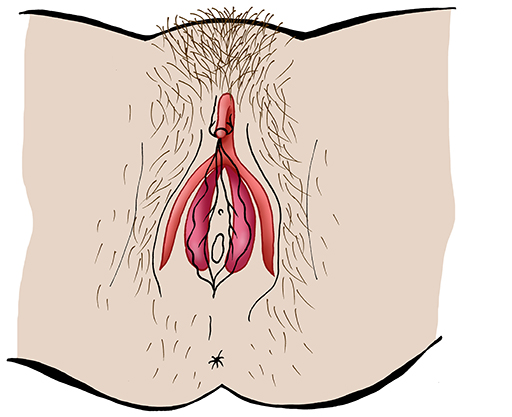
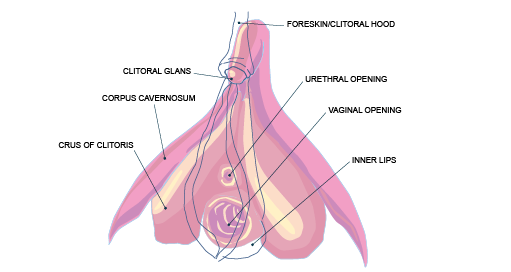
The clitoris
- The clitoris is much larger than people often assume and has internal and external parts.
- Stimulation of the clitoris is the most common way for women to have an orgasm.
Arousal
- The film focuses on arousal in the female body – people often focus more on arousal in the male body, but both are equally important to understand.
- You might want to include information about male arousal in the discussion, or at least be prepared for questions about it.
First-time sex
- There is a common myth that it will – or should – hurt for a woman or girl when she has vaginal intercourse for the first time.
- It’s connected to the myth about the hymen and that it is something that breaks the first time it’s penetrated, and that it can break from riding a horse or doing physical activities.
- It is also not true that all vaginal coronas tear and bleed the first time they are penetrated – in fact it is more common for them not to bleed.
Orgasm
- A simple way to explain an orgasm is to say that it is “the peak of sexual feeling”.
- An orgasm doesn’t feel the same every time; sometimes it is weaker, sometimes stronger.
- Very young children who have not reached puberty can also experience orgasms.
The ‘orgasm gap’
- Men have orgasms more often than women when they have sex with a partner.
- Women have more orgasms when they have sex with another woman, but significantly fewer when they have sex with a man.
- Men have the same number of orgasms whether their partner is a man or a woman.
- Here you could ask the group why they think men have more orgasms than women.
4.5 Pleasurable feelings
The next activity works well at the end of a session on anatomy, as a way to tie it all together.
Alternatively, you could use this activity on its own in a more general session. It asks participants to think about ‘good feelings’ when they are in a sexual situation and helps them to think about the difference between feelings in their body, mind and emotions.
Activity 4.7: Good feelings
Explain to students that in a sexual situation of any sort (whether kissing, sexual intercourse or something else), you should experience good feelings. These good feelings should be in your body, mind and emotions.
Write down on a chalkboard or large piece of paper ‘Good Feelings’ as a headline and then the headings below:
- in your emotions
- in your mind
- in your body.
Ask your students to give an example of a good feeling in your emotions when you are in a sexual situation, a good feeling in your mind, and so on. You can use the following list to give them some examples to help them get started, and to check that by the end you’ve covered the main points:
Good feelings – emotions: Arousal, joy, happiness, interest, and curiosity. You do not feel any strong negative feelings, such as fear, anger, guilt, shame, contempt, disgust. You may still be a little bit nervous and uncertain, but you should mainly experience positive emotions.
Good feelings – mind: Thoughts such as: “This is great!”, “This is just what I wanted!” and “I want to keep doing this”. You do not have thoughts that make you feel bad, such as: “I don’t want to!”, “If I do this, I won’t get dumped – I have to keep going!”, “I want to be anywhere else but here!” You may still have some doubts and worries, but your positive thoughts should be stronger.
Good feelings – body: Your body tells you when you want to have sex. It’s as if it longs to be touched! Your body wants to be close to the other person’s body. Your sexual organ is swollen/wet and you may feel positive feelings such as a tingling or pounding in other parts of your body. Although your body is telling you that you have a good feeling, you must always take your emotions and thoughts into account as well.
You can also have a good feeling without, at that moment, having lubrication or an erection. Erection, ejaculation or lubrication is not necessary to enjoy and feel pleasure, and you can get an erection even when you are not sexually aroused. Desire can come and go quickly, for example if you are nervous.
Close the session by writing down some main messages or ask them to summarise what they have learnt, e.g.:
- Lust and pleasure should be a central part of sex for everyone involved.
- If it doesn’t feel okay, or it hurts, you should feel able to stop or say that you want to do it another way.
- Female and male bodies respond in similar ways, and we all have the same ability to feel desire or pleasure. But, as individuals, we all also have different preferences and sensitivities.
Summary
In this learning session you have explored some resources around anatomy and the body which focus on the role the body plays in sexual pleasure. Understanding the role of anatomy in sexual pleasure helps people to have more enjoyable sex, and this can help to build better relationships. Having studied this session, you should now:
- Have some new ideas about how to include pleasure within CSE sessions you are leading which focus on anatomy and the body.
- Feel more confident about including pleasure within these sessions.
There are also some further resources on the next page if you would like to explore some of these topics in more detail.
In the next learning session, you will find some resources to help you to include discussion of sexual pleasure within sessions you are leading with focus on sexual behaviours and practices.
Further resources
If you would like to explore ‘good feelings’ further, Sex on the map is an animated educational film aimed at teenagers. In the film, we follow Abdu and Melody in their fumbling attempts to have sex for the first time with a partner.
You could just watch this film yourself, or, if you think it is suitable and you have the capacity to show films in your CSE sessions, you could show it to the young people in your group. There are teaching notes to help you.
You could ask the participants to identify the moments in the film when:
a) Melody and Abdu have good feelings in their emotions, minds and bodies.
b) Melody and/or Abdu maybe do not have good feelings.
Sex: Your own way is an English-language booklet which has been designed for teenagers by the Swedish Association for Sexuality Education (RFSU). You can read this for ideas on how to put the concepts learnt in this learning session into straightforward language. Pages 8–13 give more detail on pleasant bodily sensations and the body’s sensual places.
Read more about the orgasm gap.
Read more about the vaginal corona.
Watch a short video clip from the RFSU about the vaginal corona.
Now you can go to Learning Session 5.
